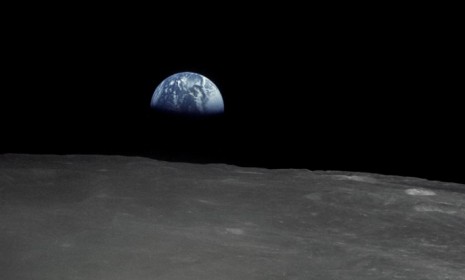NASA's 'ambitious' plan for a base off the dark side of the moon
After grounding its shuttle program, the U.S. space agency flirts with building a distant space station to serve as a jumping-off point for future missions to Mars

NASA wants to send its astronauts where no men have ever gone before. The U.S. space agency is considering building a manned space station near the dark side of the moon, in a spot that's farther from Earth than any person has ever traveled. (The preferred location is 15 percent farther from Earth than Apollo astronauts ventured.) Among other things, the outpost would serve as a "stepping stone" for future missions to Mars. Here, a brief guide to the "ambitious" project:
Where exactly would this space station be?
Off the dark side of the moon, in a part of space known as the Earth-Moon Libration Point 2 (EML-2). Think of it as a sort of orbital "parking lot," or an area of space where an object, like a space station, can be balanced between the gravitational fields of two giant masses (like Earth and the moon). While most of the dark side of the moon always faces away from Earth, a part of the dark side does tilt in our direction — and it's here that the space station would be built.
The Week
Escape your echo chamber. Get the facts behind the news, plus analysis from multiple perspectives.

Sign up for The Week's Free Newsletters
From our morning news briefing to a weekly Good News Newsletter, get the best of The Week delivered directly to your inbox.
From our morning news briefing to a weekly Good News Newsletter, get the best of The Week delivered directly to your inbox.
What would this base accomplish?
It would give next-generation space shuttles a jumping-off point for "destinations like asteroids, Martian moons, and — eventually — Mars," says Clay Dillow at Popular Science. The outpost would also help scientists observe the surface on the "rarely studied" far side of the moon and draw conclusions about the effects of long-term space habitation on the human body. In essence, the new station would serve as both a "waypoint" and a "technology test bed" for space travel.
How would it be built?
NASA would use "its heavy-lift rocket Space Launch System and the Lockheed Martin-built Orion Multi-Purpose Crew Vehicle" to provide the space station's foundational elements, and to shuttle astronauts to the station, says Britain's Daily Mail. Of course, the project would be very expensive, and take years to complete.
A free daily email with the biggest news stories of the day – and the best features from TheWeek.com
And NASA has the funds to do this?
Not quite. "President Obama just released the 2013 budget for NASA," says Jason Kennedy at PC World, "and with almost 20 percent in cuts slated to go into effect, NASA can use all of the help it can get." That's why the agency is pushing for partnerships elsewhere, including international and academic backers in the private sector. A study looking at the feasibility of the project is due back to NASA by March 30.
Sources: Daily Mail, PC World, Popular Science, Space.com
-
 Political cartoons for December 6
Political cartoons for December 6Cartoons Saturday’s political cartoons include a pardon for Hernandez, word of the year, and more
-
 Pakistan: Trump’s ‘favourite field marshal’ takes charge
Pakistan: Trump’s ‘favourite field marshal’ takes chargeIn the Spotlight Asim Munir’s control over all three branches of Pakistan’s military gives him ‘sweeping powers’ – and almost unlimited freedom to use them
-
 Codeword: December 6, 2025
Codeword: December 6, 2025The daily codeword puzzle from The Week